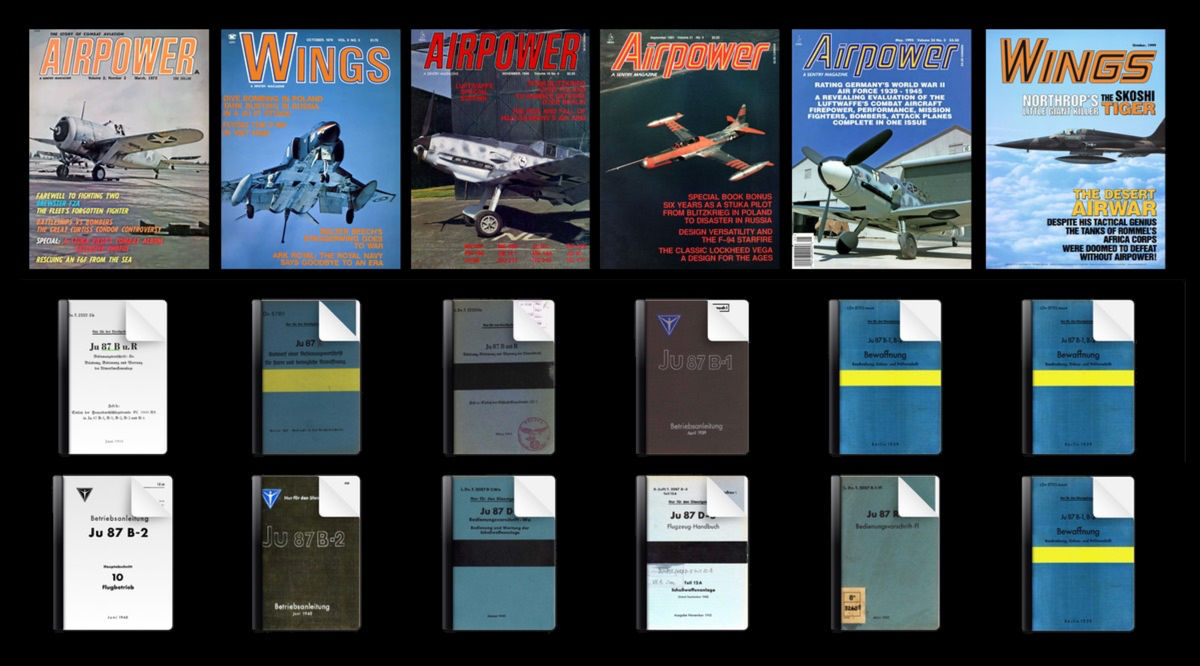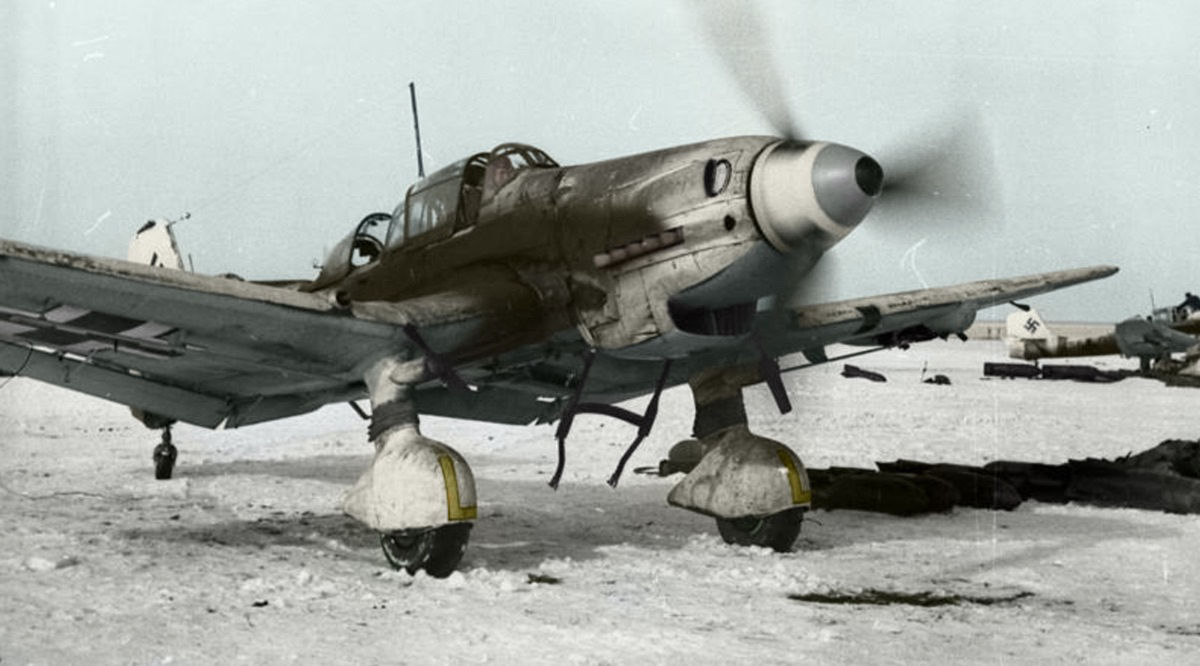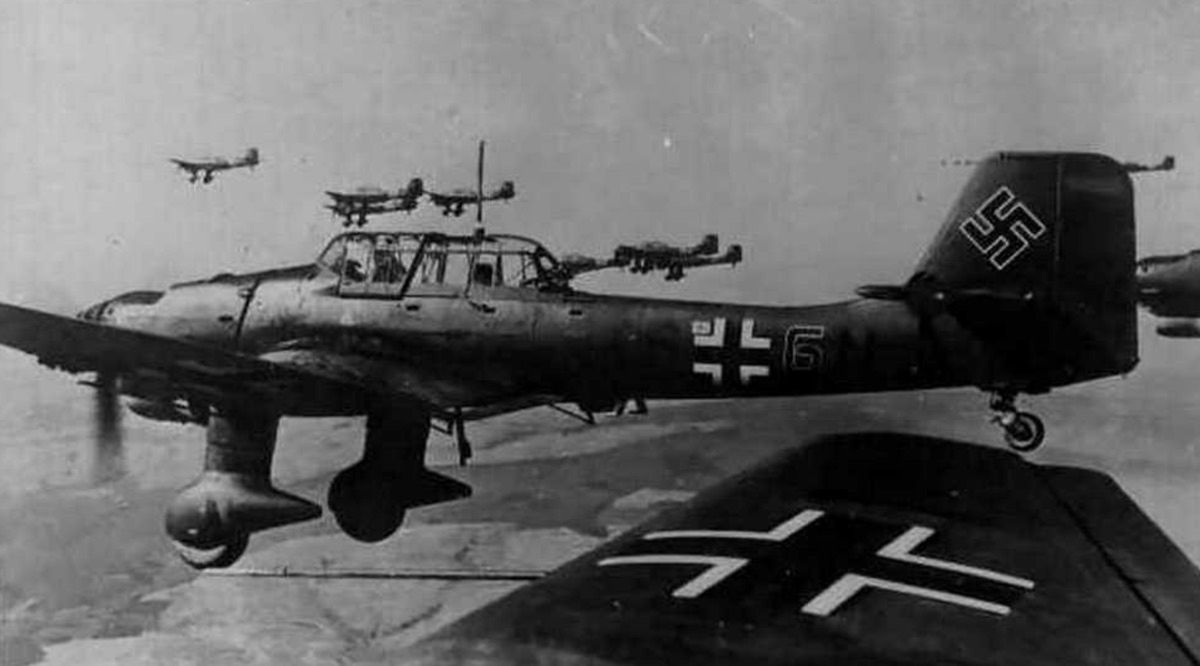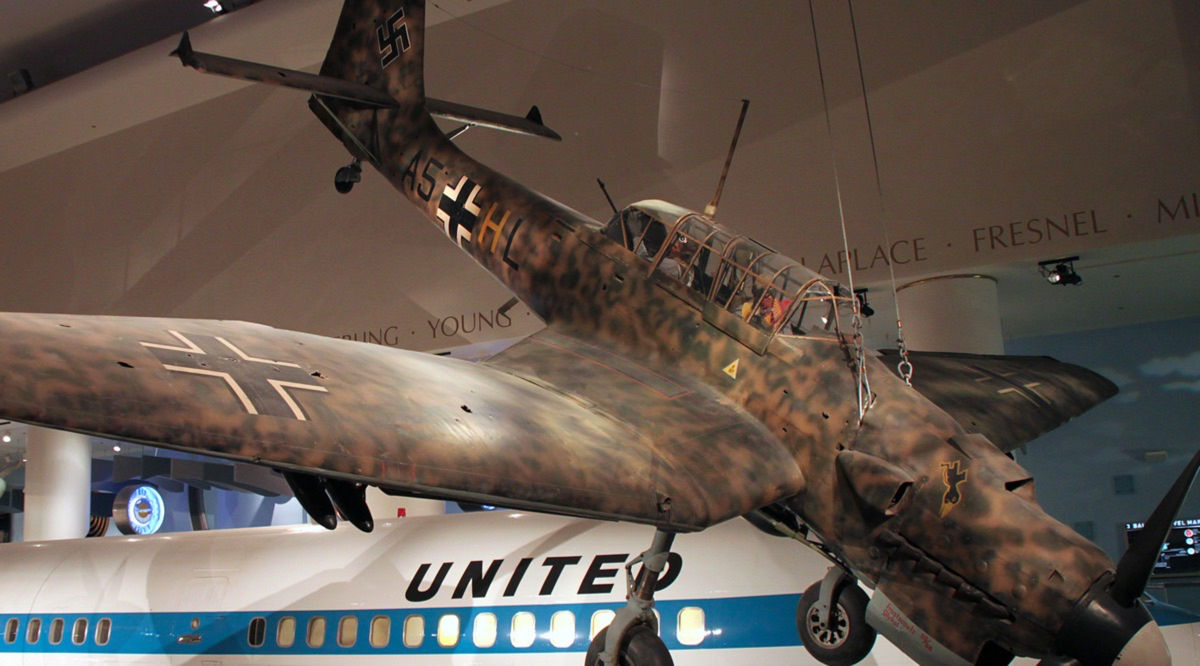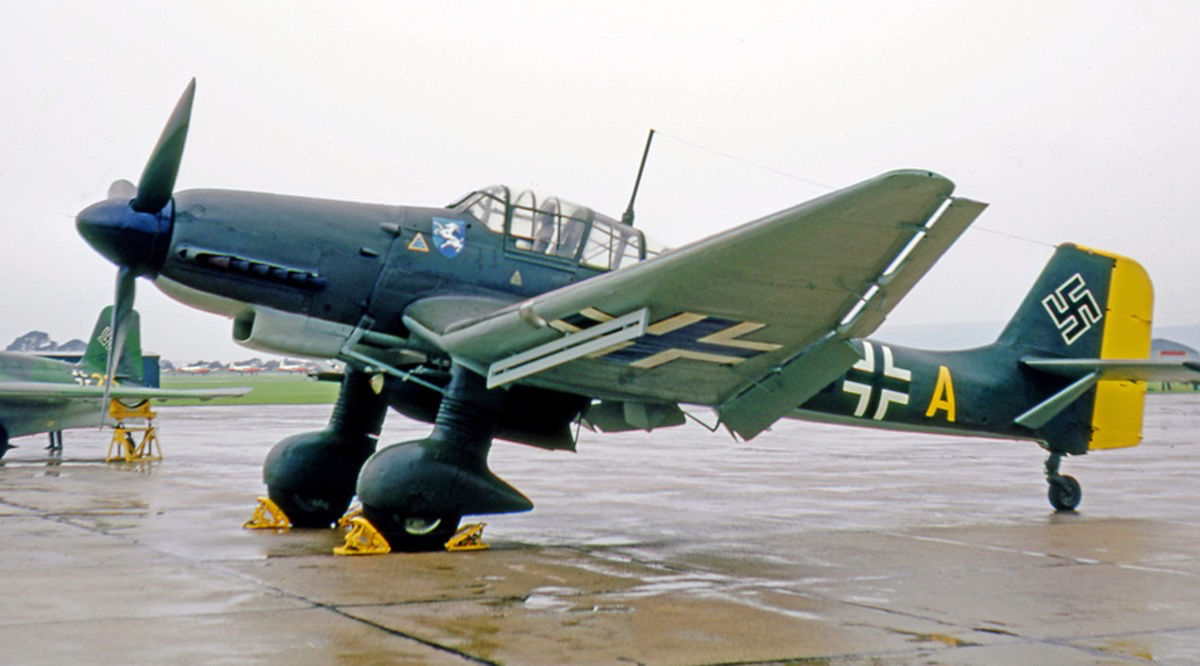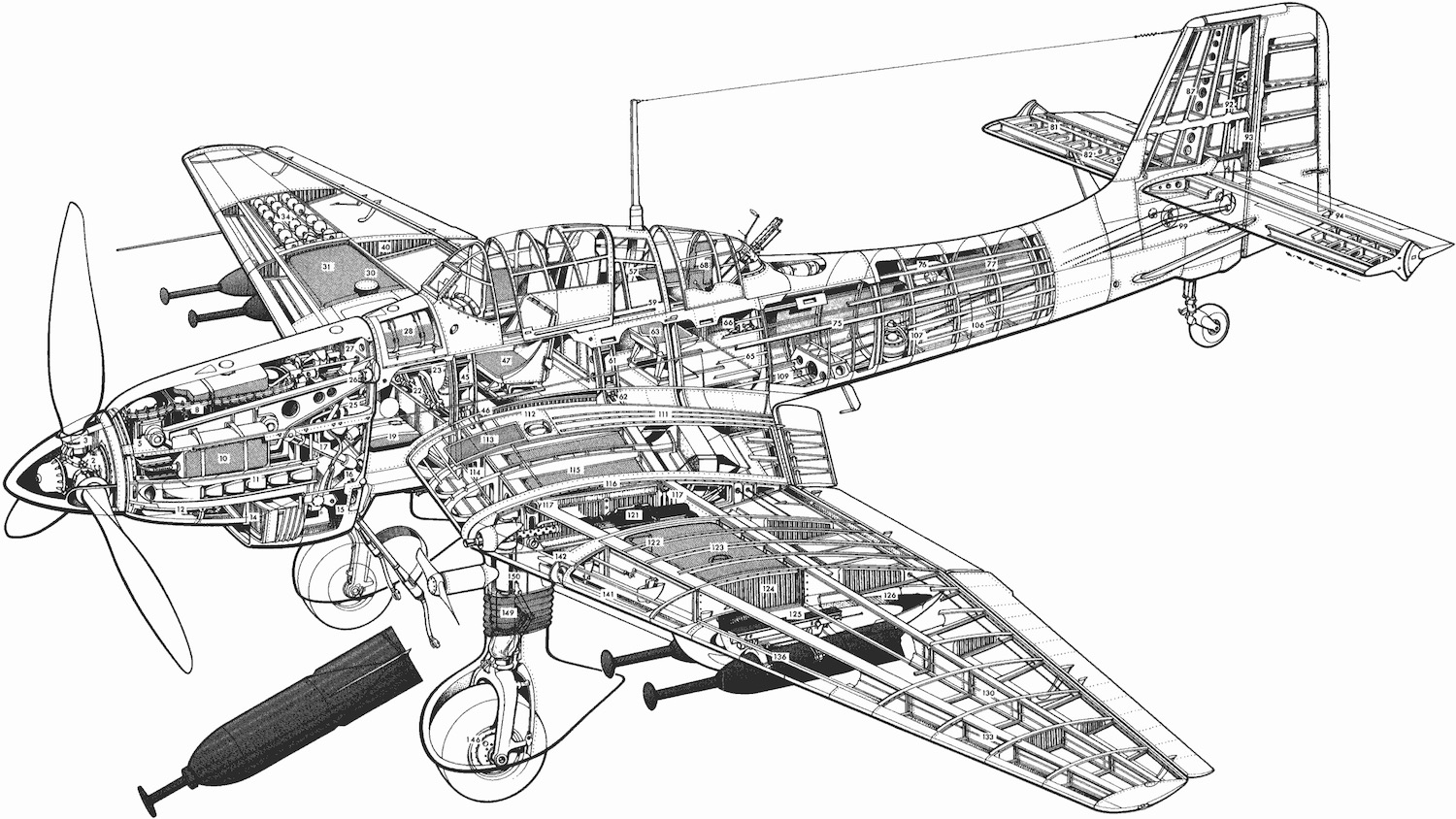Price: $19.95
- 6 magazines, 13 German manuals
- PDF contains 1,536 pages
- Content is keyword searchable
- Print a personal copy
- Pay via PayPal or Credit Card
- International orders welcome!
- Download files upon payment
March 1972
- Curtiss Condor, 1920s Vintage Wings
- The Brewster F2A Story
- Stuka, WWII’s Most Potent Propaganda Bird
- Home from the Sea, Resurrecting an F6F
- Now There’s A Rare Bird! The Breese Diving Bomber
October 1979
- Ju-87 Stuka – Dive Bombing in Poland, Tank Busting in Russia
- Flying the F-100 in Vietnam
- Walter Beech’s Staggerwing Goes To War
- Royal Navy Says Goodbye to an Era
November 1988
- Luftwaffe Special Edition, From Blitzkrieg over Poland to bomber defense over Berlin
- The rise and fall of Nazi Germany’s air arm
- Me-109, Me-262, Ju-87, Do-335, Fw-190, He-111, Me-163, Ju-52, Ju-88, Do-217, He-219, He-177
September 1991
- Six Years as a Stuka Pilot
- Design Versatility and the F-94 Starfire
- The Classic Lockheed Vega
May 1995
- Rating Germany’s WWII Air Force 1939-1945
- Evaluation of the Luftwaffe’s Combat Aircraft
October 1999
- Northrop’s Skoshi F-5 Tiger
- The Desert Air War
All German Manuals & Photos
- Ju-87 Airdrop Weapon System, 1941
- Ju-87 Armament, 1937
- Ju-87 B & R Thrown Weapon, 1941
- Ju-87 B1 Operating Manual, 1939
- Ju-87 B1,B2 Armament, 1939
- Ju-87 B1,B2 Drop Weapons, 1939
- Ju-87 B1,B2 General, 1939
- Ju-87 B2 Flight Operations, 1940
- Ju-87 B2 Operating Manual, 1940
- Ju-87 D1 Firearm System, 1942
- Ju-87 D5 Firearm System, 1943
- Ju-87 R1 Operating Instructions, 1942
- Over 80 Junkers Ju-87 Stuka photos
Junkers Ju-87 Stuka
Ju-87 B-1 Specs
Variants
On Display
Cutaway
Videos
General Characteristics

- Crew: 2
- Length: 11.10 m (36 ft 5 in)
- Wingspan: 13.805 m (45 ft 3.5 in)
- Height: 4.01 m (13 ft 2 in)
- Wing area: 31.900 m2 (343.37 sq ft)
- Airfoil: Göttingen 256
- Empty weight: 2,712 kg (5,980 lb)
- Empty equipped weight: 2,760 kg (6,090 lb)
- Max takeoff weight: 4,336 kg (9,560 lb)
- Powerplant: 1 × Junkers Jumo 211Da V-12 inverted liquid-cooled piston engine, 890 kW (1,200 hp) for take-off. 820 kW (1,100 hp) at 1,500 m (4,920 ft)
- Propellers: 3-bladed Junkers constant-speed propeller
Performance
- Maximum speed: 339.6 km/h (211.0 mph, 183.4 kn) at sea level. 383 km/h (238 mph; 207 kn) at 4,087 m (13,410 ft)
- Cruise speed: 209 km/h (130 mph, 113 kn) at 4,572 m (15,000 ft)
- Range: 595.5 km (370.0 mi, 321.5 nmi) with 500 kg (1,102 lb) bomb. 789 km (490 mi; 426 nmi) without bomb load.
- Rate of climb: 2.3 m/s (450 ft/min)
- Time to altitude: 1,000 m (3,281 ft) in 2 minutes. 2,000 m (6,562 ft) in 4 minutes 18 seconds. 3,716 m (12,190 ft) in 12 minutes
Armament
- Guns: 2× 7.92 mm (0.31 in) MG 17 machine gun forward, 1× 7.92 mm (0.31 in) MG 15 machine gun to rear
- Bombs: 1× 250 kg (550 lb) bomb beneath the fuselage and 4× 50 kg (110 lb) under-wing.
- Ju 87A (A-1/A-2)
The production Ju 87A featured the revised tail with a single fin, but the heavy `trousers’ on the fixed undercarriage of the prototype were retained, making it easy to distinguish this version from later models of the Ju 87. The radiator intake was (relatively) small and rectangular, and is another easy recognition feature. If that is not enough, the cockpit of the A-model featured two small angled out antenna masts, that were later replaced by a single, vertical one. The canopy had hinged panels instead of the sliding sections featured by later models. The Ju 87A-0 pre-production model entered service in the spring of 1937. The engine was the Jumo 210, which was to be retained in different versions by the production A-series. The 640 hp (477 kW) Jumo 210Ca for the Ju 87A-1, and the 680 hp (507 kW) supercharged Jumo 210Da for the Ju 87A-2 with an improved VDM propeller. Production of the A-series ended after 262 aircraft, at the end of 1938.The Junkers Ju 87A had two fixed, forward-firing MG 17 guns, installed in the wing outboard of the undercarriage attachment points. There was a flexible MG 15 in the rear cockpit. The Ju 87A could carry a 551 lbs (250 kg) bomb, or a 1,102 lbs (500 kg) bomb if the rear gunner was left home. The bomb was carried on a swing-down rack, a tubular structure of which the front end was attached under the engine. On release, the bomb was swung forward and downward, so that it was free of the propeller disc. (The swinging bomb crutch seems to have been an American invention. The USN considered it important enough that they refused, in 1939, to allow export of such bomb racks to France. There were also two small racks for SC-50 110 lbs (50 kg) bombs under each outboard wing panel. The equipped four Gruppen, of which StG 163 sent three aircraft to Spain during the civil war and they did see action. - Ju 87B (B-1/B-2)
An important development was that of the automatic bombing or dive control system of the Ju 87B. This consisted of an Askania autopilot, which was used together with a Revi gunsight. The bomb release gear, elevator controls, and dive brakes were linked to this system. Before attacking the pilot would set the bomb release height and go thru a checklist of about 10 items. The deployment of the dive brakes automatically set up the dive adjusting the elevator trim tab, and putting the aircraft into a dive. The use of the elevator was forbidden (except in case of emergency) so the pilot used ailerons only when setting up the attack angle via red degree lines painted at various angles on the canopy. When the bomb release height was reached and the bombs were dropped and a light came on the contact altimeter. All the pilot had to do was push a button on the control column and the autopilot adjusted the elevator trim tab again, so that the aircraft became tail heavy and pulled itself out of the dive. The pilot thus needed not to be concerned too much with the pull-out. This was just as well, because the pull-out put an acceleration of 6g on aircraft and pilot. Under such conditions one could not expect the pilot to perform complicated control sequences. Normal procedures called for a bomb release at an altitude of about 2,953 ft (900 m), which brought the Stuka down to about 1,312 ft (400 m) before it started to regain altitude.The Ju 87B was to be the standard model during the early years of World War II. It was powered by the much more powerful Jumo 211A engine. This engine had fuel injection, an important feature for an aircraft which had to be subjected to heavy G-forces and acrobatic manoeuvres making it immune to icing and engine cut-outs. A new engine cowling was designed, with a new air intake on top of the cowling, and a deep half-circular radiator under it. The radiator was larger for the B-2 model than for the B-1, because the B-2 had an even more powerful engine, and it can only be described as a deliberate insult to the aerodynamicists. The Ju 87B-1 was powered by 1,200 hp (895 kW) supercharged Jumo 211Da engine with a SC 500 1,102 lbs (500 kg) bombload. The Ju 87B-2 was an improved version with a 2,205 lbs (1000 kg) bombload. Some Ju 87B-2s flew as single seaters allowing the use of a single 2,205 lbs (1000 kg) centerline bomb.The trousered undercarriage of the A-model was replaced by a ‘spatted’ one, with closer-fitting leg covers and better streamlined wheel spats. The change was more than cosmetic, for the undercarriage was also redesigned and considerably strengthened. The mainwheels were also moved slighlty backwards. If the Ju 87 had to operate from poor airfields, such as found at the Eastern front, the spats were often removed because they tended to get clogged with mud. It was not even uncommon for Ju 87s to have their undercarriage ripped off when operating from such airfields. Speed in a dive built up to about 342 mph (550 km/h) and it became common practice to fit sirens, called ‘Trumpets of Jericho’ on the undercarriage legs in a special fitting to enhance the effect on morale of the Ju 87’s attacks. This was driven by a small propeller on the left undercarriage leg. When the siren was not installed the mount was faired over, leaving a protrusion on the undercarriage. The sirens were mostly discarded during the Battle of Britain, because they reduced the performance of the already slow and vulnerable Ju 87. The greenhouse canopy of the Ju 87B was also different of that of the Ju 87A, with sliding sections for the pilot and the gunner, which replaced the earlier hinged entry panels. The twin radio masts of the JU 87A were replaced by a single, tall, vertical mast. Italy used several examples of this aircraft under the name “Picchiatello” which led to the mistaken belief that it was made in Italy as the Breda 201. Three Ju 87B-1s made the first combat mission of World War II when they took of from Elbing at 4:26 am on 1 September 1939 and devastated the approaches to the Dirschau bridger over the Vistula at 4:34 am, some 11 minutes before Germany declared war on Poland. Subsequently, the Ju 87B-1 played a tremendous part in the Polish Campaign, destroying all but two of the Polish Navy surface warships, heavily bombing Polish troops (on many occasions within 330 ft/100 m of advancing German forces. On one ghastly occasion Ju 87B-1s virtually wiped out a Polish Infantry Division at the Piotrkow railway station. - Ju 87C (C-1)
The Ju 87C-1 was a shipboard development of the Ju 87B, intended for use on Germany’s (although never completed) aircraft carrier Graf Zeppelin. The carrier was launched at the end of 1938, but work was halted in 1940. It was resumed in 1942 but abandoned again the next year. The Graf Zeppelin was intended to carry 40 aircraft, of which 28 were planned to be Ju 87Cs. The wings of the Ju 87C had a smaller span and folded outboard of the undercarriage attachment points. The folding was similar to that used by the Grumman F4F Wildcat: the wings folded backwards with the leading edges turning down, so that they could be stored flat against the sides of the fuselage. The Ju 87C of course also had attachment points for catapult launch and a tailhook for arrested landings. The landing gear was made jettisonnable for a ditching, and flotation bags were fitted. The Ju 87C also had the capability to carry underwing fuel tanks, extending its range from 497 miles (800 km) to 994 miles (1600 km). This was to be retained for another (land-based) production model, the Ju 87R. Because the Graf Zeppelin was never completed, the Ju 87C only operated from land bases. - Ju 87R (R-1/R-2)
The Ju 87R was a long-range version of the Ju 87B, with design features of the Ju 87C. The out-of-sequence R-designation stood for `Reichweite’, or range. They were intended for anti-ship attacks, and proved very effective during the fights in Scandinavia. An additional fuel transfer system was fitted, new fuel tanks installed in the wing, and the outer wing attachment points were modified so that 300 litre fuel tanks could be carried instead of bombs. A single centerline 551 lbs (250 kg) bomb was the normal ordnance. The R-1 and R-2 were equivalent to the B-1 and B-2, but the R-1 had a longer range, because the B-2 model was heavier than the B-1. One Ju 87R aircraft was tested carrying a large container hung on the main bomb crutch, intending to carry spare parts and other cargo. - Ju 87D (D-1/D-2/D-3/D-4/D-5/D-7/D-8)
The Ju 87D had a completely redesigned engine installation. The engine was still a derivative of the Jumo 211, but the more powerful 1,410 hp (1051 kW) 211J-1 or 1,500 hp (1119 kW) Jumo 211P model was used depending on the version. The main coolant radiator was removed from under the engine cowling, and two radiators were installed under the wing centre section instead. A shallow oil cooler was retained under the engine cowling. A new constant speed Junkers VS-11 propeller with paddle blades was used. Increased armour protection for the crew was also introduced. There were also other aerodynamic refinements. The greenhouse canopy now tapered aft, instead of having a nearly constant cross-section as had that of the B-model. The aft gunners exchanged the single 75 round drum-fed MG 15 machine-gun for twin belt-fed MG 81 machine-guns.The bomb release gear was better faired in, and the maximal bomb load was increased to 3,969 lbs (1800 kg). This could include a single PC 1400 3,086 lbs (1400 kg) armour-piercing bomb on the centreline rack. The landing gear was again strengthened, but nevertheless the Ju 87D retained a reputation for landing gear collapses on rough runways. The wheel covers were again changed, and the fitting for sirens were eliminated, but after 1942 the spats and wheel fairings were increasingly discarded. The Ju 87D-2 was basically a D-1 but strengthened to equip a glider tow hook.The Ju 87D-3 introduced even more additional armour for the crew and vital parts of the aircraft reflecting the Ju 87s increasing use as a Schlachtflugzeug (close-support aircraft). From the D-4 model onwards the 7.92 mm window guns were replaced by the 20 mm MG 151/20 cannon. The Ju 87D-4 was a torpedo-bomber version capable of carrying a single torpedo with only a few example built. The Ju 87D-5 model had a longer wing span, with pointed wing tip extensions for use as a dedicated close-support version with jettisonable landing gear and no dive brakes. An interesting development was the Ju 87D-7, a night ground-attack model converted from Ju 87D-3s and Ju 87D-5s with a 1,500 hp (1119 kW) Jumo 211P engine with exhaust pipes extending back across the wing. The Ju 87D-8 was a day version of Ju 87D-7 without night-flying equipment and flame-dampers. The wing mounted machine-guns replaced by 20 mm MG 151/20 cannon and dive brakes were omitted. The Ju 87D-8 was the last aircraft type in production when in September 1944, all aircraft production other than fighters, was terminated. - Ju 87E
Like the Ju 87C had been the navalised derivative of the Ju 87B, the Ju 87E was the navalised version of the Ju 87D. But it was never built. - Ju 87F
A projected version with extensively revised airframe, an increased span wing and a more powerful engine; the considerable changes eventually brought redesignation as Ju 187, but this remained a project only. - Ju 87G (G-1/G-2)
The Ju 87G was the final version of the Stuka. It abandoned the dive attack in favour of an armament of two 37mm Rheinmetall-Borsig BK 3,7 (Flak 18 or Flak 36) anti-tank cannon weighing over 800 lbs (363 kg). These weapons fired special armour-piercing ammunition, with tungsten cores, at a muzzle velocity of 2,790 ft (850 m) per second. They were installed in gun pods fitted outboard of the landing gear legs. The ammunition was in six-round clips. The first operational trials were made in March 1943. The normal 7.92 mm or 20 mm wing guns were deleted. Dive bombing was not possible with the additional weight of the guns, so the dive brakes were also deleted. The Ju 87G could still drop bombs, but not in a dive.Initially, the Ju 87G was seen as quite dangerous to its crews. The additional weight and drag of the wing guns adversely affected performance and handling, and low-level attacks in the face of the Russian AAA and fighters seemed suicidal. But true as that was, it remained that the Ju 87G was extremely effective. The 37 mm gun was in 1943 considered obsolete as an anti-tank gun on the ground, but from the air it was still effective, because the Ju 87G could attack tanks from the rear or from above, were their armour was much thinner. Not that the Germans refrained from trying out bigger cannon on anti-tank aircraft, but the Ju 87 could not possibly carry these, and larger aircraft such as the Ju 88 were not agile enough to operate successfully against tanks. There were two versions, the G-1 and the G-2, with short and long wing spans, respectively with the G-2 based on the long-wing D-5 model. Production of the Ju 87 was halted definitively in October 1944. The greatest exponent of the Ju 87G-1 was Hans-Ulrich Rudel who was personally credited with the destruction of 519 Russian armoured vehicles. He flew 2,530 combat missions and continued to lead Stuka formations in daylight long after the other Stukagruppen had replaced their vulnerable aircraft with the Focke-Wulf Fw 190. - Ju 87H (H-1, H-3, H-5, H-7 and H-8)
The Ju 87H models were disarmed versions of the equivalent D-models, equipped with dual controls, for use as trainers. The rear cockpit design was again modified, with bulging windows to give the instructor a reasonable view forward. - Ju 87K (K-1/K-2/K-4)
The Ju 87K designation was used for export models. The K-1 was equivalent to the A-1 and intended for export to Japan. The K-2 and K-4, equivalent to the B-1 and A-1, were exported to Hungary.
Ju 87G-2 494083 displayed at RAF Chivenor in 1970 wearing inaccurate wing code W8-A, with “W8” belonging to a Messerschmitt Me 321 cargo glider unit.
A later, ground-attack variant, this is displayed at the Royal Air Force Museum in London; it was captured by British forces at Eggebek, Schleswig-Holstein in May 1945. It is thought to have been built in 1943–1944 as a D-5 before being rebuilt as a G-2 variant, possibly by fitting G-2 outer wings to a D-5 airframe. The wings have the hard-points for Bordkanone BK 3,7 gun-pods, but these are not fitted. It was one of 12 captured German aircraft selected by the British for museum preservation and assigned to the Air Historical Branch. The aircraft was stored and displayed at various RAF sites until 1978, when it was moved to the RAF Museum. In 1967, permission was given to use the aircraft in the film Battle of Britain and it was repainted and modified to resemble a 1940 variant of the Ju 87. The engine was found to be in excellent condition and there was little difficulty in starting it, but returning the aircraft to airworthiness was considered too costly for the filmmakers, and ultimately, models were used in the film to represent Stukas. In 1998, the film modifications were removed, and the aircraft returned to the original G-2 configuration.
This aircraft is displayed in the Chicago Museum of Science and Industry. It was abandoned in North Africa and found by British forces in 1941. The Ju 87 was donated by the British government and sent to the US during the war. It was fully restored in 1974 by the EAA of Wisconsin.
- Ju 87 R-4, Werk Nr. 6234 (incorporating 857509)
One aircraft is being restored to airworthy condition from two wrecks, owned by Paul Allen’s Flying Heritage & Combat Armor Museum. The project takes its identification from Ju 87 R-4 Werk Nr. 6234, which was built in 1941 and served with Stukageschwader 5. Shot down in April 1942 on a mission to bomb Murmansk, it was recovered in 1992. The wreck was purchased by New Zealand collector Tim Wallis, who originally planned for a rebuild to airworthy status, and later went to the Deutsches Technikmuseum in Berlin. Parts from a second airframe, a Ju 87 R-2 Werknummer 857509 which served bearing the Stammkennzeichenof code LI+KU from 1./St.G.5, and was recovered to the United Kingdom in 1998, have also been incorporated. The project was displayed in November 2018 and the restoration was stated to take between 18 months and two years to complete. Work will be conducted in a display hangar to allow the public to observe the work underway.
Other aircraft survive as wreckage recovered from crash sites:
- The Deutsches Technikmuseum in Berlin has the wreckage of two complete aircraft that were recovered from separate crash sites near Murmansk in 1990 and 1994. These wrecks were purchased from New Zealand collector Tim Wallis, who originally planned for the remains to be restored to airworthy, in 1996.
- The Sinsheim Auto & Technik Museum displays the remains of an aircraft that crashed near Saint-Tropez in 1944 and was raised from the seabed in 1989.
- In October 2006, a Ju 87 D-3/Trop. was recovered underwater, near Rhodes. The aircraft is now in the Hellenic Air Force Museum
- Junkers Ju 87 B-2, Code 98+01, Werk Nr. 870406, is on display at the Yugoslav Aeronautical Museum, Belgrade. The parts of three others have been found (S2+?? [StG 77]; H4+?? [Luftlandegeschwader 1]; 5B+?? [Nachtschlachtgruppe 10])
- Junkers Ju 87 B-3 Werk Nr. 110757 found in the village Kro?cienko Wy?ne in Poland in October 2015.


